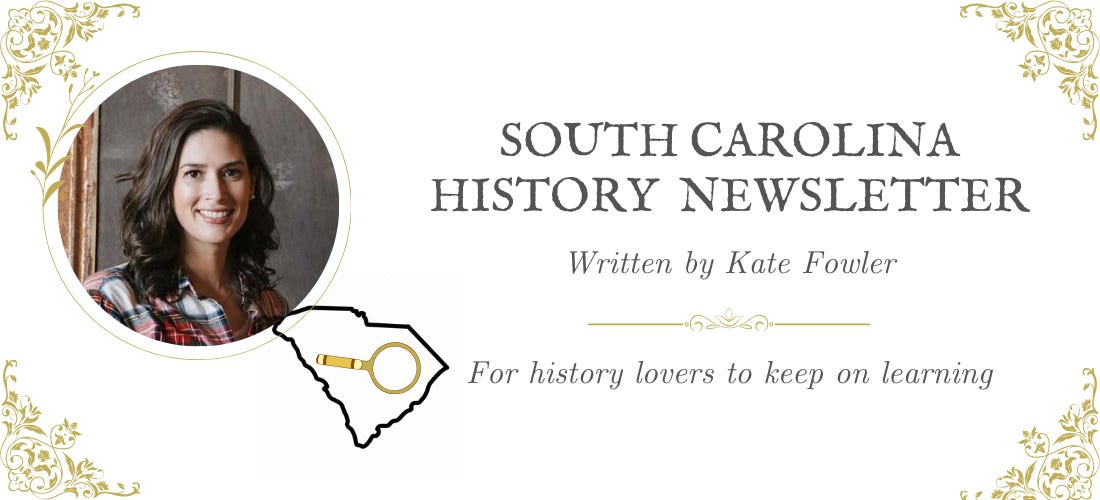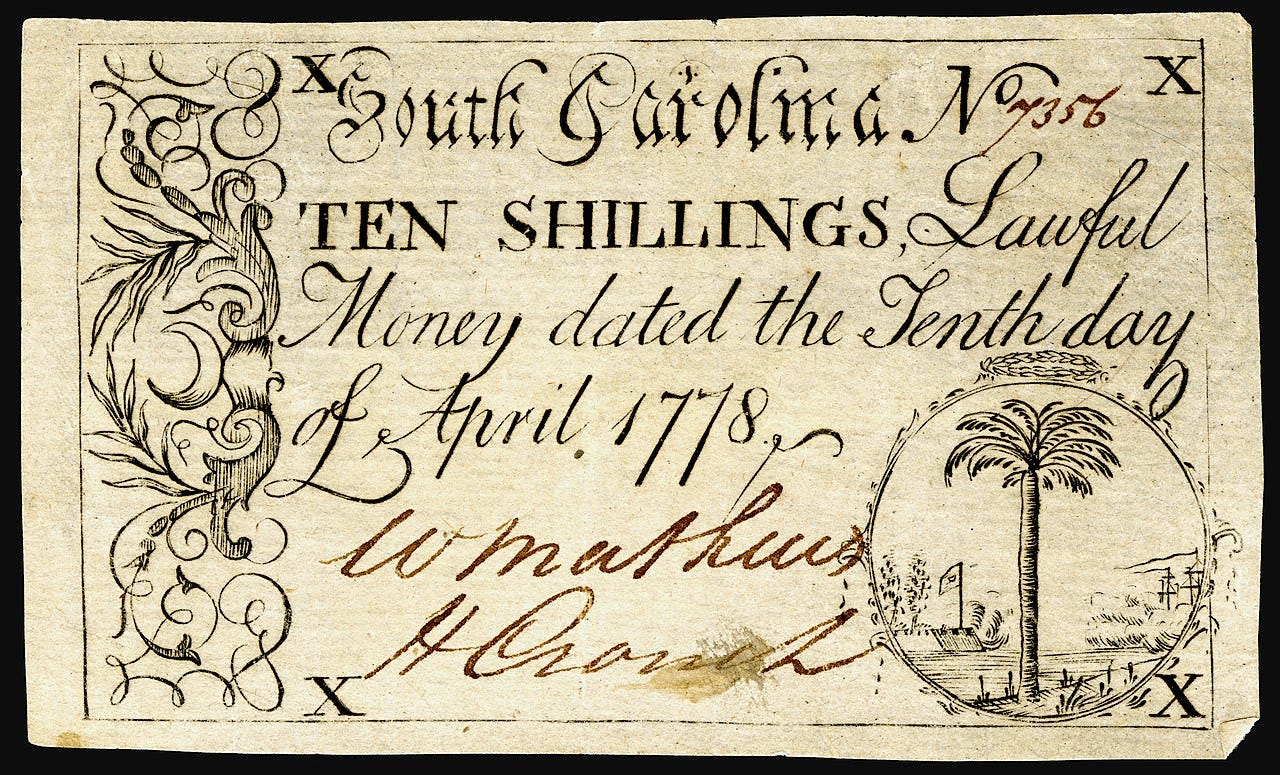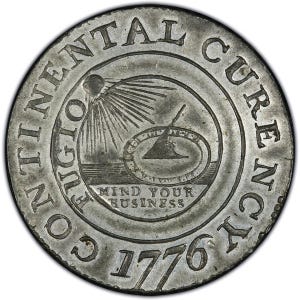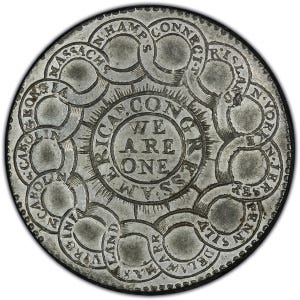#13: A woolly mammoth tooth, early SC currency, and British-occupied Charleston
For South Carolina history lovers far and wide! Enjoy weekly SC history and upcoming SC historical events
Dear reader,
Welcome to Newsletter #14 of The South Carolina History Newsletter! I’m so happy you’re here.
Welcome “daniel.hays” “woodsspring” “beverlydosborne” “ca41494” and “snjstreeter” to our SC History Newsletter community! Woohoo!
I hope you enjoy today’s newsletter, and as always, please feel free to reply to this email with your ideas and suggestions on South Carolina history you’d like to learn more about. I’m only a click away.
Additionally, please join us & keep the conversation going by becoming a member of our SC History Newsletter Facebook Community here! I can’t wait to meet you.
And now, let’s learn some South Carolina history!
Yours truly,
Kate
(Writing from Greenville, SC)
3 ➳ Upcoming SC History Events
To celebrate Black History Month, each newsletter in February highlights one Black History focused event. The Black History events will be listed first below.
While I have curated the following 3 events below to feature in today’s newsletter, please click here to visit my SC History Events Calendar that organizes all the events I have featured in the newsletter to date, as well as others I have discovered. Please let me know if you’d like to add an event to the list! Reply to this email or send me a note at schistorynewsletter@gmail.com.
I.
BLACK HISTORY MONTH HIGHLIGHT: Sunday, February 25th, 3:00 - 4:00 pm | “Health & Medicine at Redcliffe Plantation” | Redcliffe Plantation | Beach Island, SC | Tickets: $15 per person
“Learn how enslaved people cared for injuries, illnesses, and children. This program will cover a general history of health for enslaved people in the south as well as look at primary resources about medical care from James Henry Hammond’s plantations. The tour will occur throughout the historic slave quarters, garage, and mansion at Redcliffe with some portions outside – dress for the weather! Some sensitive material, recommended for ages 13 and up. Natural and herbal tea tasting included! $15 per person, please register online.”
II.
Saturday, March 2nd from 10:00 am - 4:00 pm | “Reconstruction in York County at Historic Brattonsville” | Historic Brattonsville | McConnells, SC | Tickets: Youth 4-17 ($5), Seniors 60+ ($7), Adults 18-59 ($8)
“This Living History Saturday highlights the cultural, social, and political changes in York County during the Reconstruction Era. This Saturday we will cook with recipes from What Mrs. Fisher Knows About Old Southern Cooking (one of the earliest cookbooks published by an African-American woman, 1881) and Mrs. Hill’s New Cook Book (1867). Other activities will include a quilting demonstration, Federal Army camp life, and Interpretation of the “Liberty and Resistance” exhibit in the Brattonsville Store.”
III.
Wednesday, March 20th from 6:00-7:00 pm | “Lecture #1: The Powder Magazine presents: British Occupied Charleston 1780-1782: Daily Life in a Divided City” | Old Exchange Building | Charleston, SC | FREE & Open to the public
“New research by Christina Butler and Nic Butler uncovers the stories of Charlestonians during the American Revolution. This research tells the complex story of daily life in occupied Charlestown (1780-82), with a focus on the underrepresented stories of women, free people of color, enslaved people, patriot sympathizers, loyalists, the British military, and Native Americans. This event at the Old Exchange Building is the first of four opportunities to attend this free lecture.”
2 ➳ SC History Fun Facts
I.
What did early South Carolina money look like?
The currency of South Carolina was the pound until 1793. Sterling coins were circulated along with paper money. The first issues of paper money were known as “Proclamation Money,” which were then replaced by “Lawful Money” in 1748, which looked like this:
During the American Revolution, the Colonies became independent states no longer governed by British Parliament and subject to its monetary regulations. The American Continental Congress issued paper money, known as Continental currency, to fund the war effort.
The Continental Currency dollar was valued relative to the states' currencies at the following rates:
5 shillings – Georgia
6 shillings – Connecticut , Massachusetts, New Hampshire, Rhode Island, Virginia
71⁄2 shillings – Delaware, Maryland, New Jersey, Pennsylvania
8 shillings – New York, North Carolina
321⁄2 shillings – South Carolina
The Continental Dollar coin was the first pattern coin struck for the United States and was designed by none other than Benjamin Franklin. They were minted in 1776 and were made on pewter, brass, and silver planchets. Here’s what they looked like below. I love the design, especially the “Mind your business” message on the obverse side.
II.
Here’s a story of an interesting early South Carolina fossil find…
In 1725, a crew of enslaved Africans at a place called Stono Plantation in South Carolina made a curious discovery in a swamp. They found a large, lumpy, boney object which was familiar to them. The slaves recognized the object as similar to the molar of an African elephant, “an animal they would have encountered back home in the Kingdom of Kongo.” English botanist Mark Catesby visited Stono to view the amazing discovery. The plantation owners didn’t believe their slaves when it came to identifying the fossil, and instead surmised that this ancient object was a remnant from the Biblical flood. At the time, this was a “common explanation from all oversized fossils in Europe and the American colonies.” The opinion of the enslaved crew was unanimous that the object was a tooth, and Catesby agreed with them, as he had seen enormous molars of African elephants in a London museum.
In Paris, the French naturalist George Cuvier, known as the “father of paleontology,” was intrigued by Catesby’s discovery and believed that the tooth was evidence of ancient ancestors of the common African elephant who had died out due to natural disasters many ages ago. Cuvier was impressed that “les nègres” in America had correctly identified the fossil as being related to living elephants.
About 50 years later, enslaved African workmen digging in salt marshes in Virginia unearthed teeth and “bones of an uncommon size.” Once again, the African slaves identified one of the objects as a tooth of an elephant-like creature, and once again they were correct. The fossils were sent to Thomas Jefferson, who was an avid scientist. Jefferson did not want to accept Cuvier’s idea that these enormous elephants were extinct. He was hopeful that Lewis & Clark would encounter large herds of enormous American elephants grazing in the Northwest Territories.
1 ➳ Quote from an SC historical figure
I.
“The 20th of August I saw a Comet in the North East about 2 hours before day, the 21 it was seen in the west. [Halley’s comet was then visible.]”
—Excerpt from a letter from early South Carolina settler Thomas Hewe to his father in 1682. Read more of his letters here.
Sources used in today’s newsletter:
The First Fossil Finders in North America Were Enslaved and Indigenous People
Letters of Thomas Newe to his Father, from South Carolina (1682)
I always want to improve my work. Answer the poll below to give me your review of today’s newsletter. I also welcome your suggestions for new content! Simply reply to this email with your ideas. Thank you!















